HPE ProLiant ML30 Gen10 Internal Features
Inside the chassis, one can see a fairly standard design. Airflow is designed differently from what we would see on the HPE ProLiant ML110 Gen 10. The bottom PCIe section still uses a nice airflow channel, one that is solid an, unlike the flimsy mylar pieces that lower-tier server vendors often use. Cooling the Intel Xeon E-2100 series CPU is a large fan on a radial heatsink. This is similar to but significantly more robust than Intel’s own thermal solution in this space. The rear exhaust fan pulls air through the chassis, as do the CPUs. Unlike in the ML110 Gen10, DIMMs are oriented top to bottom instead of front to back. In this lower-power platform, that is all one needs.
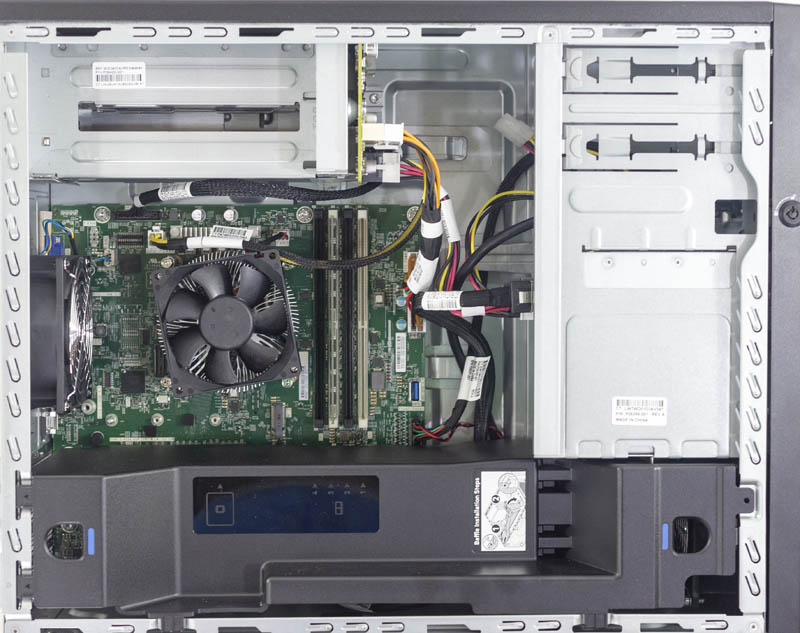
Under the airflow guide, we find four PCIe slots. One of the PCIe x16 slots is PCIe 3.0 electrical and connects directly to the CPU. Two PCIe x8 and a x16 physical slot are all PCIe 3.0 x4 electrical and connect through the system’s Intel C246 PCH.
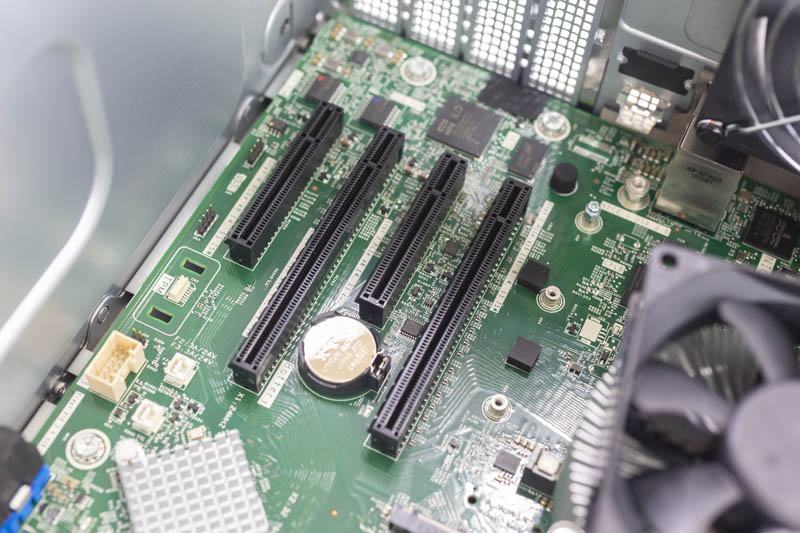
We also wanted to point out that the HPE ProLiant ML30 Gen10 includes a M.2 slot. This M.2 slot is a PCIe 3.0 x2 slot which means one does not get the full benefit on some M.2 NVMe SSDs of a x4 connection. At the same time, there are devices like Intel Optane Memory that can offer a lot of performance in a x2 electrical mode and x2 is perfectly ample for boot devices. We like the inclusion here.
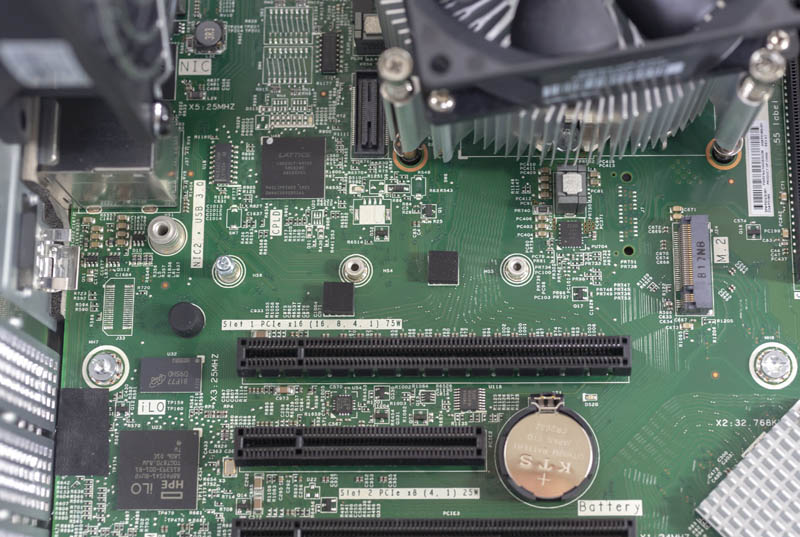
There are a total of six SATA III 6.0Gbps ports onboard. These power the front panel storage. HPE also has an internal Type-A USB 3.0 header for using internal USB media.
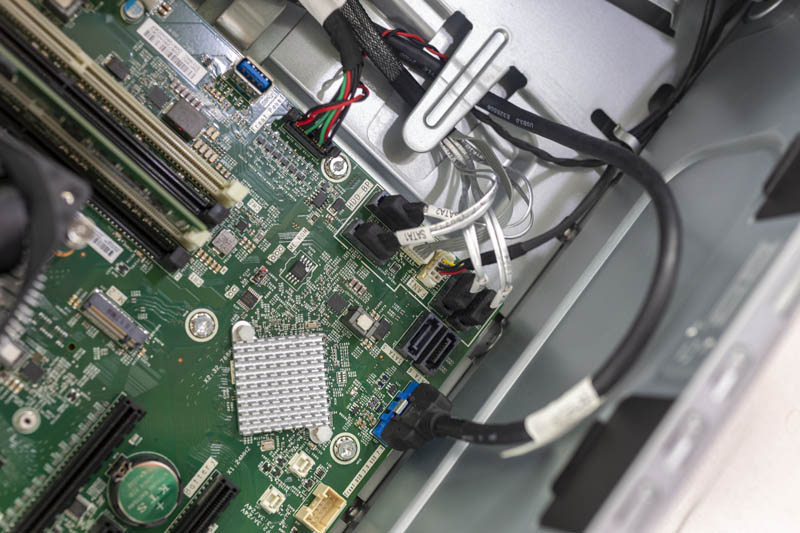
These ports connect to the backplane. As we can see, only half of the eight 2.5″ drive bays are electrically connected. HPE would suggest that you add a SAS controller if you wanted to support SAS drives and/or use all eight bays here. In the 4×3.5″ configuration, this is not necessary.
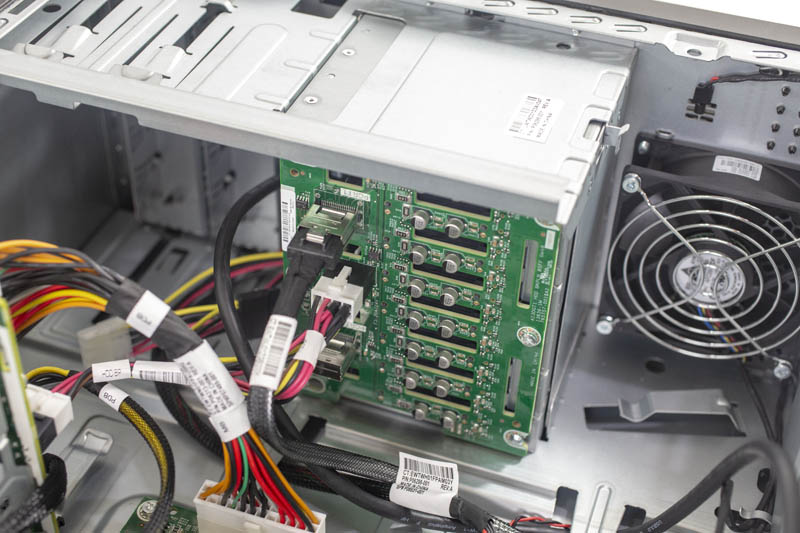
Overall, we think that the solution makes sense. The HPE ProLiant ML30 Gen10 is built significantly better than the HPE ProLiant MicroServer Gen10, but not as well as the ML110 Gen10. Since the ML30 Gen10 is designed to occupy the segment between the two, it seems HPE met their product positioning objective.
Next, we are going to look at the HPE iLO management of the ML30 Gen10 before proceeding with our review.




We use the ML30 Gen10’s for our branch offices (real estate company) and they work well. We’re using the 3.5″ versions. The new 6C E-2146G’s are what we bought based on the STH review and we’re really happy with them.
HPE became too geedy, as you could see with the iLo license. But the worst part is when you need a firmware/BIOS update and the server/adapter you have is out of warranty and you don’t have a service contract with them, then you can’t download any updates.
I have the previous gen of this server. It’s been going strong for a few years now. Only downside to ours it only takes 32gb ram due to the cpu ram limit of the Xeon e3 we have in it. I really like the quality review you guys do and welcome the amazing changes to ILo 5.
Could you please review some of Talos II systems?
https://www.raptorcs.com
Yep, since they restricted firmware updates only to clients with contract we now only buy Dell.
The difference between Dell and HP is usually small enough that these little issues are enough to justify one vs another.
Hello, I want to buy HP server for 5-10 users. I choose HPE ML30 Gen10 E-2124, 8GB, non hot plug and my question is if I can connect standard 2.5″ SSD into LFF or I should buy HPE ML30 Gen10 E-2134, 16GB hot plug SFF and there I can connect any standard SSD? Thank you for helping me
The main issue I’ve had with this server: it’s LOUD (as in: hear it in the next room loud) as soon as there’s something in the PCIE slots. This happened with all the NICs available to me, unfortunately (various vendors and generations). Only caveat: while I did have HPE NICs (NC560SPF+), this formally isn’t a supported model for this server. I did not have one of the supported models to test, but my experience with HPE so far (we’re running HPE at work) in this respect makes me doubt it will be quieter with a formally supported NIC.
Solution has been to remove the HP fans, short some fan header pins to make the server believe the fans are fine, and use aftermarket fans and fancontroller.
The optional dedicated ILO header slots into the M2 slot, and provides a new slot in replacement. It does not provide an additional M2 slot. Not a huge issue, but you might be dissappointed otherwise.
Would love to know what IJdo Dijkstra did re the fan replacement. I agree. Incredibly loud because in an otherwise great server they use cheap Delta fans. I have replaced the cpu cooler – massive difference. But the chassis fans are difficult with non-standard headers. I can see too the I will possibly need to look at the hotswap PSU fan or PSU altogether – man when that ramps up it is impressive!
I also note in our SFF version, placing non-HP drives in the smart caddies initially ran as expected, but a firmware change must have now picked up that the drives are non-HP and they choose to disable the activity lights on the smart caddies – pretty petty HP !